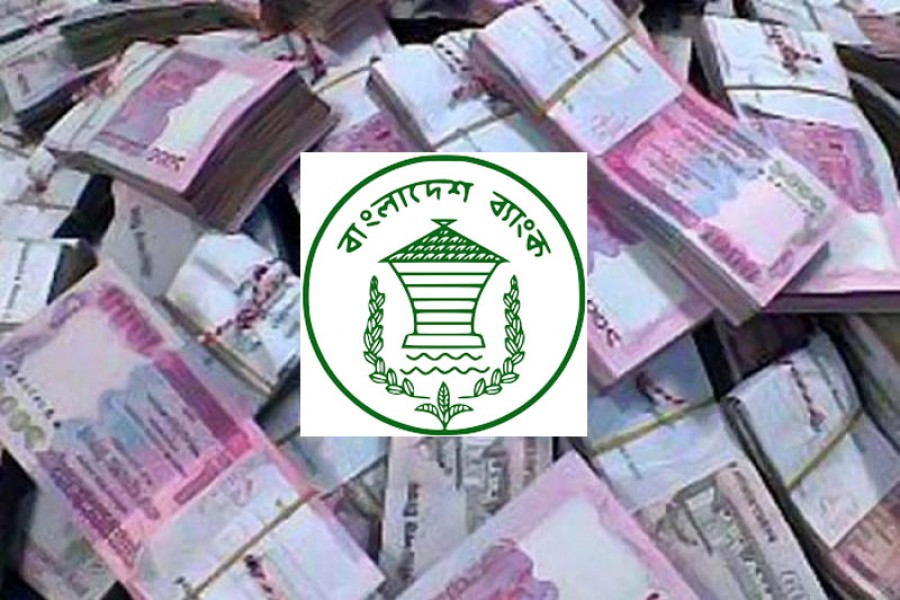The overall excess liquidity with the commercial banks fell substantially in November this year mainly due to higher credit growth, particularly in the private sector.
Officials said the central bank also sold significant amount of US dollar in the recent months, contributing to help the commercial banks reduce their liquidity.
The excess liquidity came down to Tk 900 billion in the first week of November last from Tk 1.06 trillion in the last week of June, according to latest statistics of Bangladesh Bank (BB). It was Tk 1.23 trillion in the last week of December last year.
"A significant amount of local currency has already gone to out of circulation as the central bank sold the US dollar to the banks," a senior official at the BB said.
An amount of Tk 79.29 billion entered into the BB's vault in exchange of US$ 972 million sold by the central bank to the banks during a period from July 01 to December 21 this year, according to a BB report obtained by the FE.
The BB is now selling the foreign currency to the banks directly for paying import bills particularly of fuel oil, food grains and capital machinery, according to the central banker.
The demand for the greenback was gradually increasing, mainly due to higher import payments, particularly of capital machinery, petroleum products and consumer items like food grains, according to the market operators.
Another BB official said that major portion of the excess liquidity has already been invested in the government-approved securities and BB bills as a risk-free investment for the banks.
On the other hand, excess reserve, generally known as excess over daily minimum cash reserve requirement (CRR) with the central bank, rose to Tk 55 billion in the first week of November last from Tk 42 billion in June 2017, the central banker added.
"Such reserve has increased slightly due to the government's negative borrowing from the banking system," he said.
The central banker expected that the falling trend of excess liquidity might continue in the coming months if the existing private sector credit demand persists.
Meanwhile, the private sector credit growth increased significantly in October due to higher trade financing for settling the import payment obligations, bankers said.
The growth in credit to the private sector rose to 18.63 per cent in October 2017 on a year-on-year basis from 17.80 per cent a month ago, according to the central bank's latest statistics.
Such credit growth has already crossed the target, set by the BB in its latest monetary policy statement.
Earlier on July 26 last, the central bank had projected in its first half-yearly (H1) monetary policy statement for the fiscal year (FY) 2017-18 that the private sector credit would grow at 16.2 per cent in December 2017 and 16.3 per cent in June 2018 respectively.
Besides, implementation of different infrastructure projects along with the mega projects has pushed up the overall private sector credit growth, they added.
Currently, the government is implementing nine big projects, including Padma Bridge, under the Fast Track Project Monitoring Committee, headed by Prime Minister Sheikh Hasina.
The total outstanding loans with the private sector rose to Tk 8,126.80 billion in October last from Tk 8,012.25 billion in September 2017. It was Tk 6,850.81 billion in October 2016.
The bankers said that lower interest rates on lending and political stability have also encouraged the entrepreneurs to borrow more from the local sources to meet their growing demand for investments.
The weighted average interest rates on lending came down to 9.39 per cent in October 2017 from 9.45 per cent a month ago. It was 10.15 per cent in September 2016.
The overall deposit rate witnessed an upward trend in the recent months, following higher credit growth particularly in the private sector.
The weighted average interest rate on deposits rose to 4.89 per cent in October last from 4.84 percent in June 2017, the BB data showed.
Most of the banks have already offered a maximum deposit rate of 8.50 per cent instead of 7.0 per cent earlier, particularly in cases of FDRs (fixed deposit receipt), to the state-owned enterprises (SoEs) and non-government organisations (NGOs) to collect funds, according to the market insiders.
They also said that the fourth generation private commercial banks were now offering a maximum interest rate of 9.0 per cent to the SoEs and NGOs to collect funds.
Market insiders expect that the uptrend in interest rate on deposits would continue in the coming months as most banks were offering higher interest rates to increase their deposit growth more than that of the credits.
Echoing with the BB officials, Syed Mahbubur Rahman, newly elected chairman of the Association of Bankers, Bangladesh (ABB), said the existing falling trend of excess liquidity might continue in the coming months if the ongoing higher private sector credit growth persists.
Considering recent trend of deposit over advance, Mr. Rahman, also managing director and chief executive officer of Dhaka Bank Ltd, thought it would be prudent on our part to focus more on mobilising deposits so as to avoid any crunch situation that may occur in future.
The growth in deposit, year-on-year basis, came down to 11.08 per cent as on September 14 last from 12.21 per cent in March 2017.
All banks' deposit growth was 13.13 per cent in December 31, 2016.
On the other hand, the all banks' credit growth rose to 17.70 per cent during the period from 15.90 per cent as on March 30, 2017. It was 15.32 per cent in December 31, 2016.


